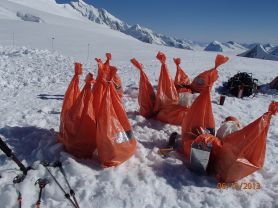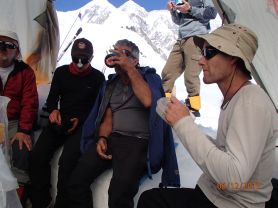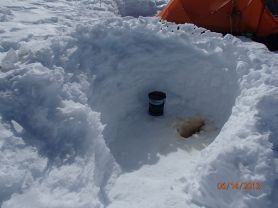
|
Mount McKinley 2013 - Food and Drink |

|
Without sufficient calories you obviously lose weight. That may be O.K. while working 9 to 5 at a desk job, and may even be preferable for one's long term health.
However
It's a combination of the cold and physical work. Fully 85% of food's energy content goes to simply heating your body above the surrounding temperature. It's a huge waste, in a sense, because it means only 15% of what's consumed actually goes to moving your mass uphill. With low environmental temperature the required energy to maintain body core temperature rises markedly. Hence just sitting in the cold, even with multiple layers, raises the metabolic rate relative to home.

|
|
Each bag holds a days worth of expedition meals. Note gallon of fuel. (DC) |
Now add physical labor. What results for camp moving days is a daily energy requirement double your normal calorie needs. A typical expedition food supply calls for 2 pounds of dry food daily - roughly 3,500 to 4,000 Calories. If you don't eat that amount weight is lost, and as commonly occurs on Mount McKinley climbs. Ten pounds is typical. I lost nothing, which is to be considered a minor triumph.
High altitude tends to diminish appetite. In addition fats are poorly tolerated at seriously high elevation. Hence it is well to plan meals accordingly, with an increasingly larger fraction of total calories as carbohyrate rather than fat and/or protein. The resulting diet can become monotonous. In contrast, I found that on our expedtion every meal had an acceptable balance of these items.

|
At Mount McKinley dehyration is an omnipresent threat, lurking silently in the background and compromising the climber who fails to recall that he must drink more than he "feels like". High altitude and cold dry the air, robbing it of almost all moisture content. Hence just the act of breathing releases more water vapor than can be taken in - and the effect increases as you climb higher.

|
| Inside the kitchen tent at 9,600 feet. (DC) |
Perhaps one gallon daily suffices, including all fluid naturally contained in food. Regardless, our two one-liter water bottles are generally topped-off before leaving camp since then there is no opportunity for melting snow, to replenish supplies, until either returning there or establishment of a new one.
Unfortunately water is pretty much tasteless. It's one of G-d's mistakes, failing to flavor the water molecule. Citing its smallness is not an excuse since table salt, NaCl, is equally tiny yet is hugely tasty.
To render water palatable one uses powdered drink mixes. I bring enough of this sugar-free stuff to flavor 40 quarts, corresponding to 2 quarts daily over a 20 day expedition. The balance of my hydration requirement comes in-camp as more enjoyable alternatives - hot chocolate, oatmeal for some breakfasts, soup at most dinners and pasta (which is roughly 80% water by weight after cooking).
Parenthetically I note that pasta has advantages over pizza, sandwiches and enchiladas at suppertime on the glacier -
Taken collectively, this need for food and water has an immediate consequence -
The aircraft taxi companies provide gallon tins of Coleman brand fuel. A three week expedition plans on one gallon per climber, the main use being to melt snow for water.
Food preparers should note the following facts regarding how much energy is required to simply melt snow versus heating it to boiling (such as for cooking pasta).
Thereby the vast majority of fuel requirement goes to simply melting snow as distinct from additionally heating it to either a "hot drink" temperature or to the boiling point for cooking purposes.

|
|
Super-sophisticated outdoor plumbing for our post-prandial convenience. (DC) |
That's for an idealized system without heat loss in the process. Doubtless one strives to minimize this effect, through insulation, one that becomes increasingly difficult as the water temperature rises owing to the increased thermal gradient.
Drinking ice-cold water is not ideal, requiring energy for heating it to body temperature after consumption. Given the small fractional increment in required fuel, heating meltwater to at least "room temperature" seems advisable.
Water boils at an increasingly lower temperature with rising elevation. Sparing the details (which I once explained at mealtime), the approximate result is a linear decrease of 1 degree Centrigrade (1.8° F) for every 1,000 feet of elevation. Thus at Advance Base Camp water boils at roughly 186° F - while at the summit it boils at only 175° F.
This has immediate implications for how long it takes to cook (and sterilize) food. Would the additional weight of a pressure cooker be offset by a corresponding savings in fuel requirement? Likely not. However it would be beneficial anywhere animal power carries the burden - such as Aconcagua's Plaza de Mulas (14,200 feet) and Everest Base Camp (17,500 feet).

|
The following is a compendium of what is eaten on the expedition.
Mouse-click on any of the photographs to stimulate YOUR appetite!
Breakfasts

|
ttention to variety is never keen with breakfast, be it here or in the typical home. In part this arises because, let's face it, standard breakfast fare is inherently not as varied as lunch or dinner.
On this expedition all hot meals are group affairs as this proves efficient for planning and preparation. However on a private climb it is quite sensible to have individual tastes accomodated.
Regardless of this dichotomy,
VARY
THE
MENU
TO
STIMULATE
THE
APPETITE.
Here are the breakfasts we ate, including my recommendations for potential improvement
where it exists. Moving days result in quicker affairs, obviating pancakes
which are individually cooked on the griddle.
All mornings include a hot beverage, the choice
depending on what you selected in Anchorage and/or brought from home. Coffee in some form is
generally available.
We could have enjoyed scrambled eggs at breakfast. A cheesy omelet would be better still!
However I have found that powdered eggs taste bad upon rehydration. Furthermore, they provide no
carbohydrate as required for performance enhancement. To bring real eggs up the mountain courts
disaster should they break. They also have a lower than ideal calorie / weight ratio.
Hot Lunches

|
here are a pair of hot lunches enjoyed at Advance Base Camp on days
we wait for diminished winds higher up the route.
It is about then, at ABC, that my lower lip becomes blistered enough to adversely impact eating. I can no longer spice food, not even add salt, with considerable pain passing it through my lips. Pieces of each sandwich are first torn off with fingers, the individual bites carefully inserted. By the time I leave ABC this issue has self-resolved, presumably for having taken a pair of courses in Valtrex - an anti-herpes medication.
Dinners

|
am thoroughly pleased with the variety and quantity of food available for the day's main meal. A soup course often preceeds the entrée, while a dessert sometimes follows it. The soup provides needed hydration, the dessert tops-off calories. I could live on dessert alone with vitamin pills!
The following items are enjoyed, along with recommendations for possible improvement. The only item truly lacking and which should be addressed is provision of salt within the group spice kit.
Any complaints noted are peculiar to myself, I don't believe that others are quite as nitpicky - these should be considered the opinions of a foodie and definitely not indicative of normality.
Once we have cheesecake adorned with dried blueberries.
Another time we have Oreo cookies spread liberally with cream cheese cake frosting.
I take my share and add a flavor dimension with jelly beans.
On several nights we split a pair of gourmet chocolate bars - one milk chocolate, the other dark chocolate. People are fair, and, knowing I love dessert (this was demonstrated at the Bear's Tooth in Anchorage), make certain that I get to enjoy the remaining squares. In fact, I quite often get served first if and only because I always demonstrate a huge enthusiasm for whatever is offered.
I also make certain to thank the specific guides who prepare my meal.

|
|
Post-expedition in Anchorage - from viewer's left we have Caitlin, Zach, Dan, James, Nickel and Yoshiko. (DC) |
Snacks

|
ll food apart from breakfast and dinner is included here. We each bring snack food for personal consumption, the resulting items necessarily different between individuals.
The variety available is staggering, and is divided into two camps - savory and sweet. Among savory items we have salmon jerky, meat jerky (multiple varieties) peanut butter crackers, corn nuts, sticks of cheddar cheese and little wheels of "Laughing Cow" processed cheese (regular and low calorie), cashews, almonds, mixed nuts and "trail mix".
Sweet items include chocolate-based candy bars (Snickers, Butterfinger, Hershey's Almond, Kit-Kat, Caramelo, etc...); granola bars and so-called energy bars (some with up to 30 grams of protein); squishy gummy-bear-like chews, Jelly Belly jelly beans (49 flavors), Famous Amos chocolate chip cookies, and my favorites - dried blueberries in dark chocolate plus almonds and coconut in dark chocolate.
There are also drink mixes available - cocoa (regular and sugar-free), instant coffee crystals, apple cider powder (surely just flavored sugar), and low calorie powders to flavor water.

|
bring several items from home that I know are supremely tempting and hence will be eaten,
there being no benefit, indeed a detriment, in carrying undesirable food...
The number of items selected from our expedition's snack stores is configured such that my total snack item mass is tolerably similar to what it would have been had I not brought any food from home. After all, I am carrying it uphill. Thus the recommended "100 items" of snack items is replaced with 80, the above food from home comprising the difference.

|
f you are halfway normal then food is a welcome companion in an otherwise difficult day - be it from boredom in a storm-bound tent, or as the sole creature comfort on an exhausting, twelve hour march. Do yourself a favor and plan to bring enough food, and in sufficient variety to make every meal something to anticipate with relish.
A privately arranged McKinley climb might see dinner items similar, if not altogether identical to, what I devised for Aconcagua in 2006 - yet perhaps modified to accomodate the unique tastes of every attendee. The actual list makes me hungry.
| previous page - Meteorology | next page - Overall Impressions and Conclusion |